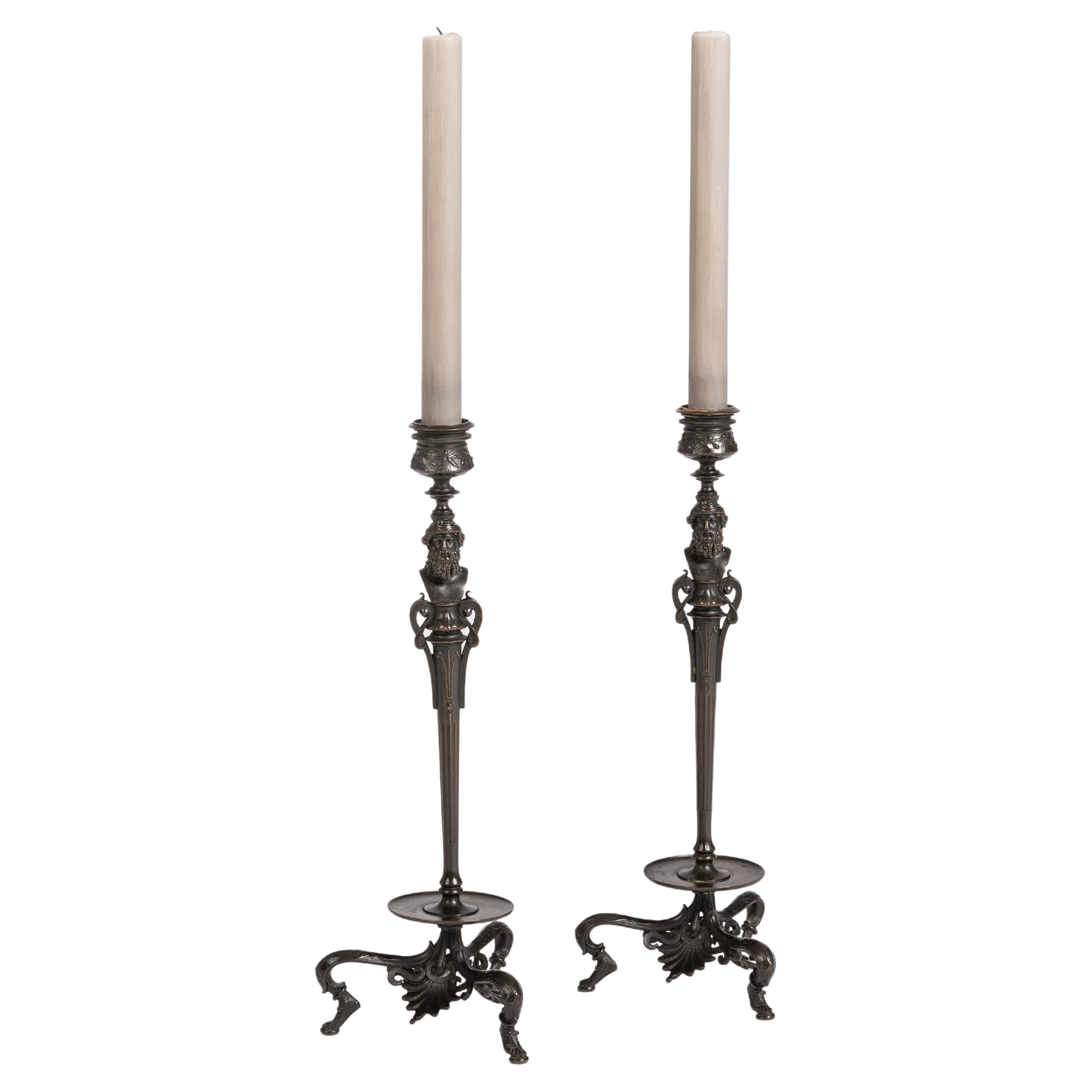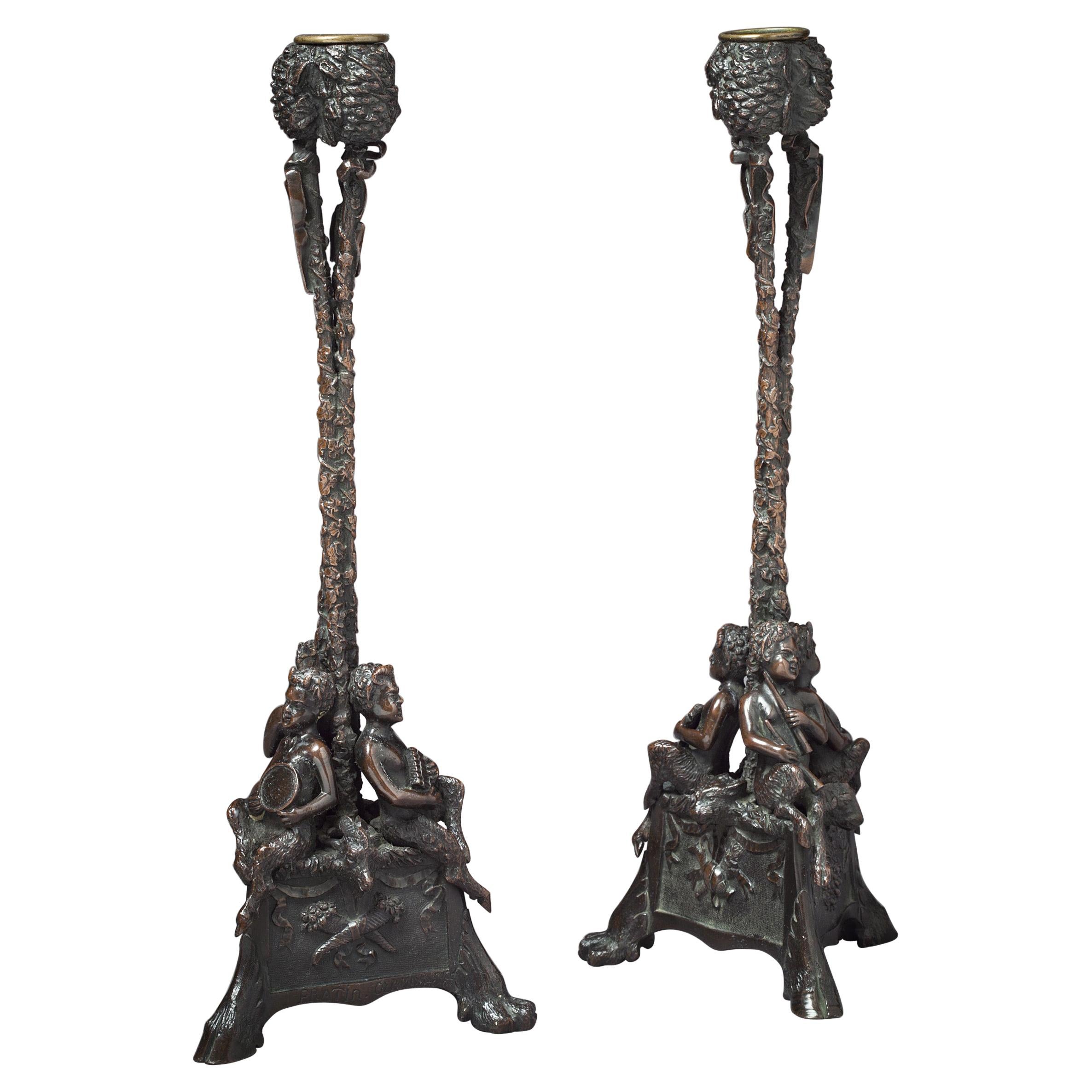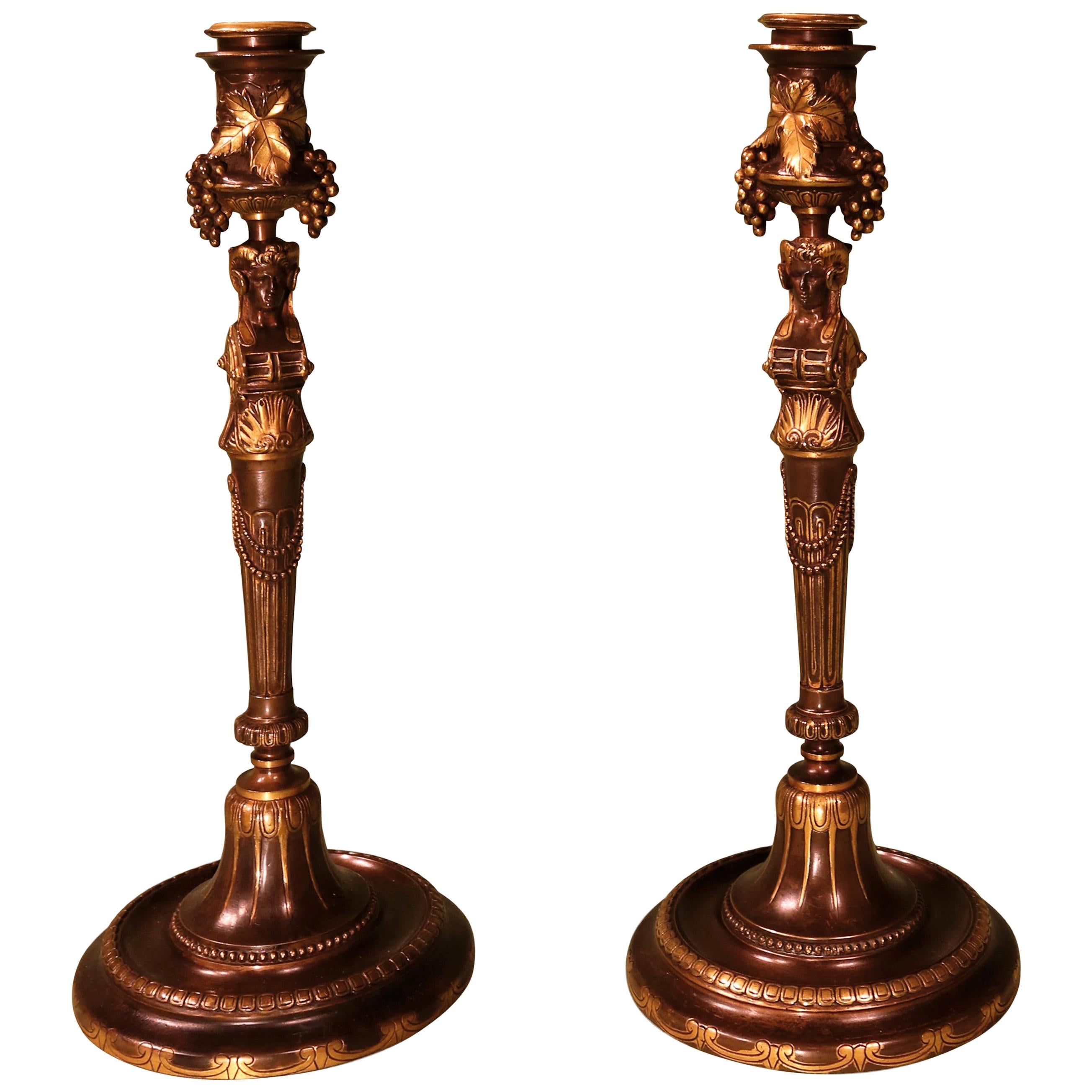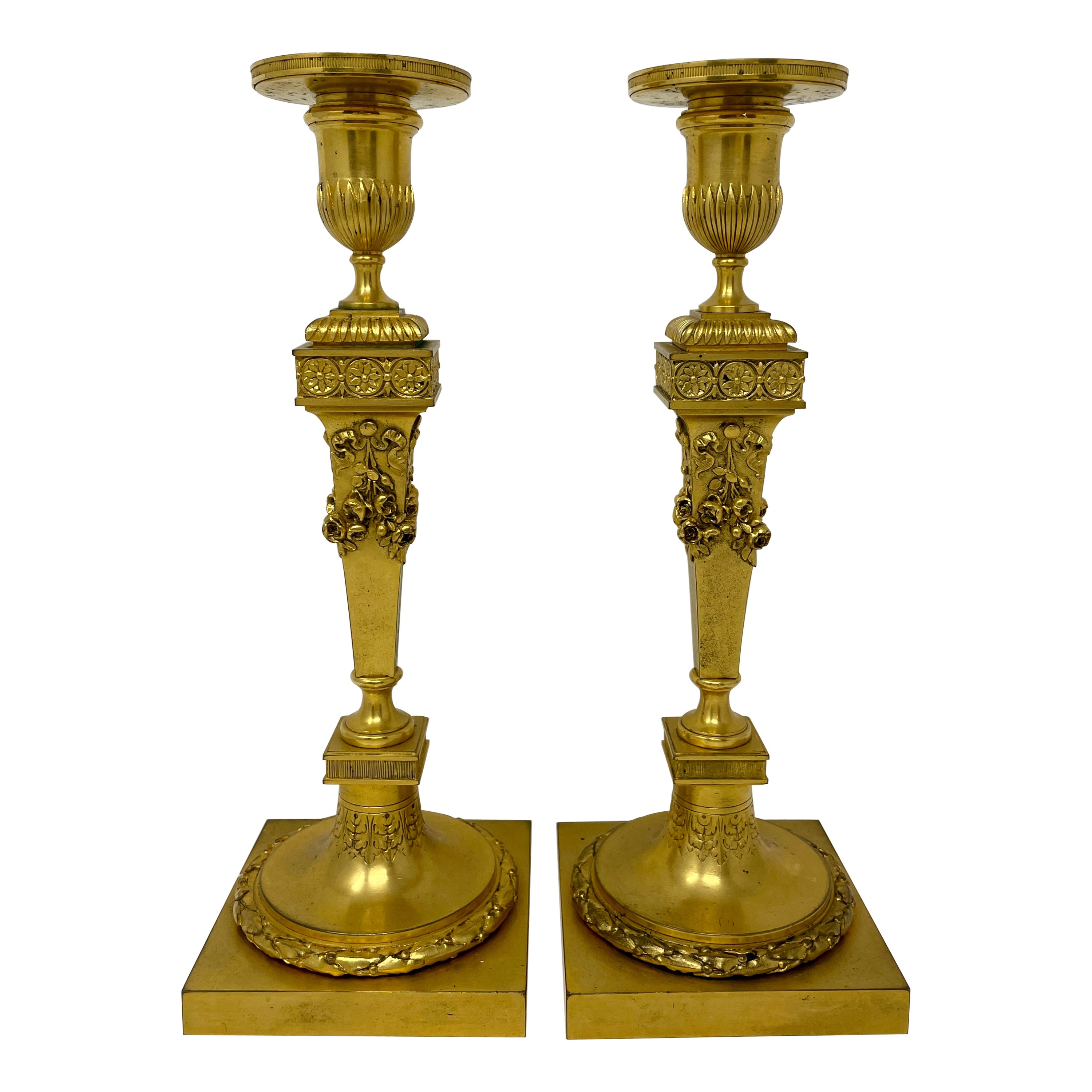Items Similar to Pair of Classicistical Fire Gilded Candlesticks France 1840 by F. Barbedienne
Want more images or videos?
Request additional images or videos from the seller
1 of 6
Pair of Classicistical Fire Gilded Candlesticks France 1840 by F. Barbedienne
About the Item
Pair of strict classicistical fire gilded candlesticks France 1840, signed Barbedienne.
Strict classicist design with square base, flowers and leaf ornaments in different finish. Decorated and smooth elements in alternation create otically balanced object.
The widest part of the stem is 4.0cm
Ferdinand Barbedienne (* August 6, 1810 in Saint-Martin-de-Fresnay, Calvados department, France; † March 21, 1892 in Paris) was a French sculptor, bronze ware manufacturer, and gallery owner. One of the most important and popular Éditeurs d'art, or publishers of art articles, he had most of the French sculptors of his time under contract.
Life and work
Ferdinand Barbedienne was the son of a farmer. At the age of 13, he learned the Craft of saddlery.
In 1822 he moved to Paris, where he first worked as a clerk in a wallpaper shop. He received start-up capital from his employer to open his own store, which he set up on Rue Notre-Dame-de-Lorette in 1834. He pursued the idea of exhibiting bronze statues in addition to his core business and mass producing them in small format.
In 1838, he joined forces with the mechanic Achille Collas, who had developed the machine á reduction (réducteur for short); a device based on the principles of the pantograph that could reproduce three-dimensional objects in any size - reduced or enlarged. On November 29, 1838, both signed the founding contract for the company Société Ferdinand Barbedienne et Achille Collas, which aimed to commercially exploit the mechanized production of sculptural works for an initial 20 years. Barbedienne took care of the commercial management of the company, while Collas contributed the patent on his invention and seven existing machines, and with his profound knowledge of machinery was responsible for the production processes. Together they decided on the subject matter of the objects, the selling prices, and all other financial matters.
In 1841, they produced casts of the Apollo of Belvedere, the Spinario, and 21 pieces with the motif of a bas-relief of the Parthenon. These were followed by versions of the Laocoon group, the Venus of Arles, and the Borghese Fencer, among others. Special interest was initially shown in works from antiquity, for which casts from the Atelier de Moulage in the Louvre served as models. The company continued to produce works by representatives of the Renaissance such as Michelangelo, Donatello, Giovanni Bologna or by French sculptors such as Jean Goujon, Jean-François Flamand, Pierre Puget, François Girardon, Antoine Coysevox, Christophe-Gabriel Allegrain, Étienne-Maurice Falconet, Jacques Caffieri, Jean-Antoine Houdon and others. Great interest was also shown in works by well-known contemporary artists, with prizes received such as the Prix de Rome, membership in the Société des Artistes Français, or awards of the Cross of the Legion of Honor being some of the selection criteria.
In 1843, Barbedienne signed his first publishing contract with François Rude for the serial reproduction of a contemporary artist's works for the artist's lifetime, which quickly brought the company international renown. The first catalog was printed that same year, with others following about every two to three years. In 1847, the company established a foundry in Paris, whereupon Barbedienne became a member of the Réunion des Fabricants. Despite some difficulties during the February Revolution of 1848, the company's activities expanded, and it now turned to the manufacture of decorative arts objects such as mantelpieces, chandeliers, and candelabras. At that time, the Barbediennes store was located on Boulevard Poissoniére, and the workshop on Rue de Lancry. In 1851 he signed a contract with sculptor Jules Cavelier for an unlimited edition of his work Pénélope, which - originally created as Femme grecque endormie in 1842 - earned Barbedienne two Grand Médailles at the 1851 Great Exhibition in London. At the 1855 Paris Universal Exhibition, he received the Grand Médaille d'Honneur and eleven Médailles de Coopérateurs. During this period, Barbedienne secured the exclusive right of ownership and reproduction for the entire oeuvre of Auguste Clésinger. Barbedienne's biggest competitor was considered to be the Susse Frères foundry.
In 1859 Achille Collas died, whereupon Barbedienne continued to run the company alone with 300 workers. He received further awards at the London World's Fair in 1862. In 1865, he was elected president of the Réunion des Fabricants and held this position until 1885. In 1874, Barbedienne was admitted to the Legion of Honor as a commander. To compete with Japanese imports, which were in vogue at the time, Barbedienne experimented with new techniques for applying champlevé enamel and partitioned enamel between 1860 and 1890. During the Franco-Prussian War of 1870-71, the company made 70 cannons for the French Ministry of Defense.
After his death in 1892, Barbedienne was buried in the Père Lachaise cemetery. By then he had received numerous awards. By the time of his death, his company employed 600 workers and had produced some 3000 objects of art as well as decorative art objects in bronze. His products were also known and in demand abroad. He was one of the most important and popular manufacturers of bronzes, having contracted most of the sculptors of his time, including Antoine-Louis Barye, Barye le fils, Émile-Coriolan Guillemin, François Joseph Bosio, Jean-Baptiste Carpeaux, Henri Chapu, Pierre Jean David D'Angers, Emmanuel Frémiet, François Jouffroy and Auguste Rodin.
After his death, the company was continued by his nephew Gustave Leblanc-Barbedienne, who had previously been appointed as a partner. Leblanc-Barbedienne established sales branches in the United States of America, the Netherlands, the United Kingdom and Germany in 1913, although the demand for Industrial small sculptures was already declining. In the United Kingdom, the company worked with Jackson & Graham in London and Thomas Agnew & Sons in Manchester and Liverpool, and in the United States with the Bigelow-Kennard company in Boston and Tiffany & Co. in New York City. The company was discontinued in 1954.
- Dimensions:Height: 11.42 in (29 cm)Width: 3.94 in (10 cm)Depth: 3.94 in (10 cm)
- Sold As:Set of 2
- Materials and Techniques:
- Period:
- Date of Manufacture:1840
- Condition:
- Seller Location:Salzburg, AT
- Reference Number:1stDibs: LU2438328084402

About the Seller
5.0
Vetted Seller
These experienced sellers undergo a comprehensive evaluation by our team of in-house experts.
Established in 2000
1stDibs seller since 2016
70 sales on 1stDibs
Typical response time: 1 hour
- ShippingRetrieving quote...Ships From: Salzburg, Austria
- Return PolicyA return for this item may be initiated within 7 days of delivery.
More From This SellerView All
- Pair of French Napoleon III Bronze Candlesticks by Foundry F. Barbedienne 1860sBy F. Barbedienne FoundryLocated in Salzburg, ATPair of very elegant classicist candlesticks in fine patinated bronze, signed BARBEDIENNE. The execution of the casting is extremely finely worked with delicate leaves on the outer wall of the candlestick, with a head of antiquity on the upper part of the stem which flows into the lower part with fluting and side volutes. The 3 curved legs stand on raised feet with delicate strappy sandals. Measures: The diameter at the top is 3.5cm and at the bottom 13.5cm Ferdinand Barbedienne (* August 6, 1810 in Saint-Martin-de-Fresnay, Calvados department, France; † March 21, 1892 in Paris) was a French sculptor, bronze ware manufacturer, and gallery owner. One of the most important and popular Éditeurs d'art, or publishers of art articles, he had most of the French sculptors of his time under contract. Life and work Ferdinand Barbedienne was the son of a farmer. At the age of 13, he learned the Craft of saddlery. In 1822 he moved to Paris, where he first worked as a clerk in a wallpaper shop. He received start-up capital from his employer to open his own store, which he set up on Rue Notre-Dame-de-Lorette in 1834. He pursued the idea of exhibiting bronze statues in addition to his core business and mass producing them in small format. In 1838, he joined forces with the mechanic Achille Collas, who had developed the machine á reduction (réducteur for short); a device based on the principles of the pantograph that could reproduce three-dimensional objects in any size - reduced or enlarged. On November 29, 1838, both signed the founding contract for the company Société Ferdinand Barbedienne et Achille Collas, which aimed to commercially exploit the mechanized production of sculptural works for an initial 20 years. Barbedienne took care of the commercial management of the company, while Collas contributed the patent on his invention and seven existing machines, and with his profound knowledge of machinery was responsible for the production processes. Together they decided on the subject matter of the objects, the selling prices, and all other financial matters. In 1841, they produced casts of the Apollo of Belvedere, the Spinario, and 21 pieces with the motif of a bas-relief of the Parthenon. These were followed by versions of the Laocoon group, the Venus of Arles, and the Borghese Fencer, among others. Special interest was initially shown in works from antiquity, for which casts from the Atelier de Moulage in the Louvre served as models. The company continued to produce works by representatives of the Renaissance such as Michelangelo, Donatello, Giovanni Bologna or by French sculptors such as Jean Goujon, Jean-François Flamand, Pierre Puget, François Girardon, Antoine Coysevox...Category
Antique 1860s French Napoleon III Candlesticks
MaterialsBronze
- Pair of French Napoleon III Candlesticks Bronze & Bronze Firegilt by A. DaubréeBy Alfred DaubréeLocated in Salzburg, ATPair of French Napoleon III candlesticks in bronze and bronze fire gilt designed, manufactured and signed by Alfred Daubrée, Nancy. The cast bronze body...Category
Antique 1860s French Napoleon III Candlesticks
MaterialsBronze
- Set of 3 High Black Ebonized Carved French Napoleon III Candlesticks 1860sLocated in Salzburg, ATSet of 3 large black ebonized French Napoleon III candlesticks. The turned candlesticks have an elegant siluette the slightly higher base of 15cm diameter and 7cm height on 3 small round baroque feet forms the base. The conical, slender central base is inlaid at the bottom with a triple turned baluster stem and at the top with a turned plate as a subdivision and on a small baluster above it the slender and elongated candlestick stem. The set of 3 candlesticks...Category
Antique Mid-19th Century French Napoleon III Candlesticks
MaterialsWood
- French 18th Century Classicistical Directoire Trumeau/Mirror in White/Gold PaintLocated in Salzburg, ATFrench, Classic Directoire Trumeau 18th century gold / white Very fine representation of an antique chariot with handlebar. Framed with pearl frieze ...Category
Antique 1790s European Directoire Trumeau Mirrors
MaterialsWood, Mercury Glass
- Pair of Italian Mid-Century Acrlyic Table Lamps Gilded Base by F. Loffredo 1970sLocated in Salzburg, ATPair of very chic acrylic glass table lamps by Ferdinando Loffredo. The conical, clear acrylic base has a ribbed profile at the top and bottom, with a small brass rim at the bottom....Category
Vintage 1970s Italian Mid-Century Modern Table Lamps
MaterialsBrass, Gold Leaf
- French Gilded Bronze Table Lamp by Pierre Casenove for Fondica, 1980sBy Pierre CasenoveLocated in Salzburg, ATA fantastic 1980's sculptural gilt table lamp by Pierre Casenove for Fondica, signed. Heavy, cast bronze object, fire-gilded. The electrics have been completely reworked, 2 transver...Category
Vintage 1980s French Mid-Century Modern Table Lamps
MaterialsBronze, Foil
You May Also Like
- Ferdinand Barbedienne Pair of French Egyptian Revival Figural CandlestickLocated in New York, NYPair of French Egyptian Revival candelabra by Ferdinand Barbedienne (France, 1810-1892) Two-arm candleholder extends above a stylistic Egyp...Category
Antique 19th Century French Egyptian Revival Figurative Sculptures
MaterialsBronze
- Pair of Bronze Candlesticks, circa 1840Located in New York, NYBy Christophe Fratin (1800-1864).Category
Antique 1840s French Candlesticks
MaterialsBronze
- Pair of 19th Century French Bronze and Ormolu Barbedienne CandlesticksBy Ferdinand BarbedienneLocated in London, GBAn unusual pair of mid-19th century French bronze and ormolu candlesticks, having grape and vine nozzles raised on swaged, fluted tapering stems surmounted by classical busts of man ...Category
Antique 1860s Candlesticks
MaterialsBronze
- Antique French Barbedienne Enamel Candlestick HolderBy Ferdinand BarbedienneLocated in New York, NYAn antique French Barbedienne enamel candlestick holder. Crafted with meticulous attention to detail, this piece showcases the intricate champleve enamel technique, a hallmark of the Barbedienne workshops expertise. The vibrant enamel hues contrast beautifully against the rich tones of the metalwork, creating a harmonious and visually striking spherical composition. The piece is elevated by a sturdy marble base, adding a touch of luxury and stability to its overall aesthetic. Circa the late 19th century. Antique French Enamel Candlesticks...Category
Antique Late 19th Century French Candlesticks
MaterialsEnamel
- Pair Antique French Barbedienne Bronze D' Ore Candlesticks, circa 1880Located in New Orleans, LAPair antique French Barbedienne bronze d' ore candlesticks, circa 1880.Category
Antique Late 19th Century French Candlesticks
MaterialsBronze
- Pair of Elegant French Gilded Bronze Candlesticks, circa 1890Located in Bath, GBA wonderfully elegant pair of cast bronze candlesticks, French in origin and dating to circa 1890. This size is perfect for a desk-top or mantelpiece with a base measuring approxi...Category
Antique 1890s English Edwardian Candlesticks
MaterialsBronze
Recently Viewed
View AllMore Ways To Browse
Selling Price
Antique Fire Signs
Antique Fire Sign
Fire Of London
1840 Flowers
Antique Furniture Sales
Gilded Furniture Ornaments
French Antique Reproductions
French Antique Reproduction
City Of Rome Furniture
Gilded Saint
American Gilded Age
1851 Great Exhibition
City Of Boston
French Department Store
French Antique Furniture Reproduction
French Antique Reproduction Furniture
French Reproduction Antique Furniture





